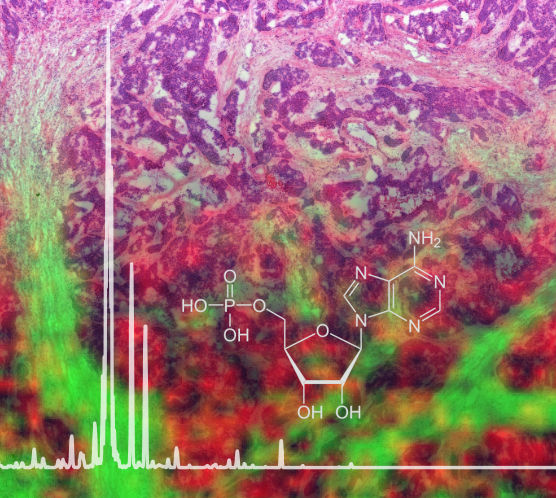New protocol enables analysis of metabolic products from fixed tissues
Scientists at the Helmholtz Zentrum München have developed a new mass spectrometry imaging method which, for the first time, makes it possible to analyze hundreds of metabolites in fixed tissue samples. Their findings, published in the journal Nature Protocols, explain the new access to metabolic information, which will offer previously unexploited potential for tissue-based research and molecular diagnostics.

A new mass spectrometry imaging protocol allows the analysis of metabolites like Adenosine monophosphate from FFPE tissue, shown here as background.
Helmholtz Zentrum München
In biomedical research, working with tissue samples is indispensable because it permits insights into the biological reality of patients, for example, in addition to those gained from Petri dishes and computer simulations. The tissue is usually fixed in formalin and embedded in paraffin wax in order to keep the tissue, as far as possible, in its original condition for later analyses.
It was previously assumed that in material that had been treated in this way an analysis of metabolites, in contrast to DNA or proteins, would be barely possible for technical reasons. A team of scientists from the Analytical Pathology department at the Helmholtz Zentrum München led by Prof. Axel Karl Walch has now succeeded in refuting this belief.
Fixed tissues accessible on a large scale
The researchers developed a protocol which makes it possible – within one day – to determine the metabolite composition of tissues using a mass spectrometry imaging approach, and to make it visible in tissue sections. Relatively small amounts of material are required for this, according to the authors. “Our method permits the analysis of minute biopsies and even tissue micro-arrays, making it particularly interesting for molecular research and diagnostics,” explains doctoral candidate Achim Buck, together with Alice Ly, the first author of the study.
In order to ensure that the measured data was not falsified by the fixation process, the authors compared it with the measured values for the same samples that were not fixed but were shock frozen. “A large proportion of the measured metabolites occurred in both analyses,” reports Achim Buck. “We were able to show that the method works reliably and avoids the complex logistics and storage of shock-frozen samples.”
In addition to simple handling and high reproducibility, the possibility to conduct high throughput work is a key advantage of the new method*, according to the scientists. Above all, however, it is now possible to study the spatial distribution of molecules in the tissue graphically and with great precision. “That is an enormous advantage, both in research and in clinical diagnostic practice,” research team leader Walch says, assessing the new possibilities. “Using our new analytical method, our aim is now to identify new predictive, diagnostic and prognostic markers in tissues, as well as to understand disease processes.”
The scientists hope that publication of the protocol will also lead to an exchange with and further developments by colleagues with a view to advancing metabolic analyses of archived tissues.
Original publication
Alice Ly, Achim Buck, Benjamin Balluff, Na Sun, Karin Gorzolka, Annette Feuchtinger, Klaus-Peter Janssen, Peter J K Kuppen, Cornelis J H van de Velde, Gregor Weirich, Franziska Erlmeier, Rupert Langer, Michaela Aubele, Horst Zitzelsberger, Liam McDonnell, Michaela Aichler & Axel Walch; "High-mass-resolution MALDI mass spectrometry imaging of metabolites from formalin-fixed paraffin-embedded tissue"; Nature Protocols; 2016
See the theme worlds for related content
Topic World Mass Spectrometry
Mass spectrometry enables us to detect and identify molecules and reveal their structure. Whether in chemistry, biochemistry or forensics - mass spectrometry opens up unexpected insights into the composition of our world. Immerse yourself in the fascinating world of mass spectrometry!

Topic World Mass Spectrometry
Mass spectrometry enables us to detect and identify molecules and reveal their structure. Whether in chemistry, biochemistry or forensics - mass spectrometry opens up unexpected insights into the composition of our world. Immerse yourself in the fascinating world of mass spectrometry!






















































